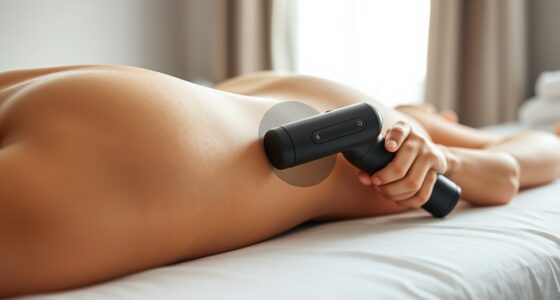Percussive therapy can help reduce muscle tension and relieve some fibromyalgia symptoms by promoting blood flow and relaxing tight muscles. While many users report decreased pain and improved relaxation, it’s not a guaranteed or universal solution. There are risks and limitations, so you should always consult healthcare professionals before trying it. To understand how this therapy fits into a holistic management plan and uncover more insights, keep exploring the details.
Key Takeaways
- Percussive therapy may reduce muscle tension and pain but is not a cure for fibromyalgia.
- Its effectiveness varies; some patients experience symptom relief, while others see minimal benefits.
- Consulting healthcare professionals before use is essential to ensure safety and appropriate application.
- Combining percussive therapy with other treatments and lifestyle changes can enhance overall symptom management.
- Ongoing research aims to understand its long-term benefits and role within comprehensive fibromyalgia care.
Understanding Fibromyalgia: Symptoms and Challenges
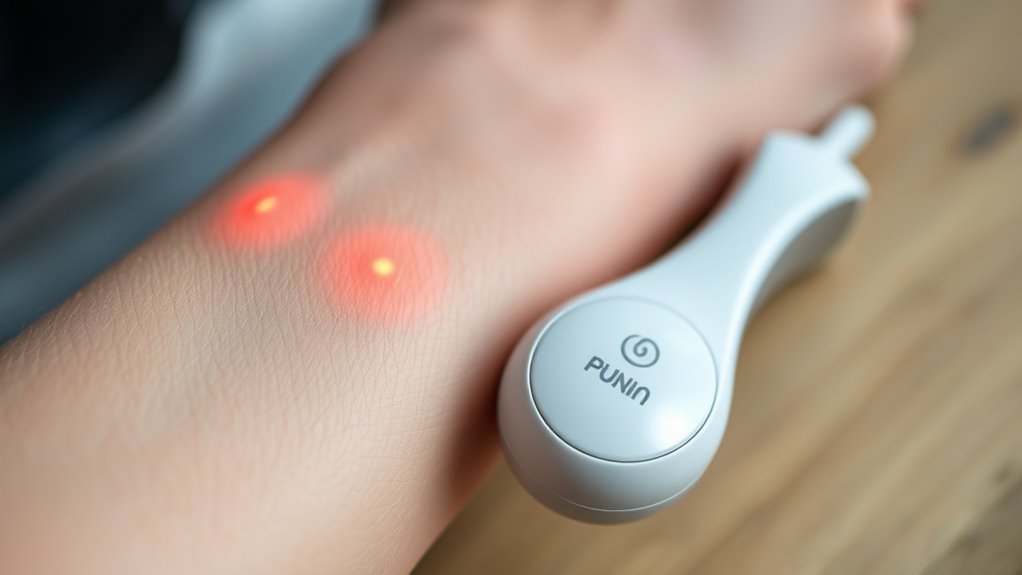
Fibromyalgia is a chronic condition that causes widespread pain and tenderness throughout your body, often making everyday activities challenging. You might notice persistent fatigue, sleep problems, and cognitive difficulties called “fibro fog.” Understanding the mind-body connection is essential because stress and emotional health can worsen symptoms. Many people explore alternative therapies, such as acupuncture, meditation, and gentle exercise, to help manage pain and improve quality of life. These approaches aim to ease the physical and emotional burdens of fibromyalgia by fostering relaxation and reducing stress. Recognizing the complex nature of this condition helps you develop a personalized approach to treatment, emphasizing both physical and mental well-being. Staying informed about symptoms and challenges empowers you to seek effective strategies for managing your condition. Incorporating mindfulness techniques can also play a significant role in managing stress and alleviating symptoms.
How Percussive Therapy Works and Its Intended Benefits
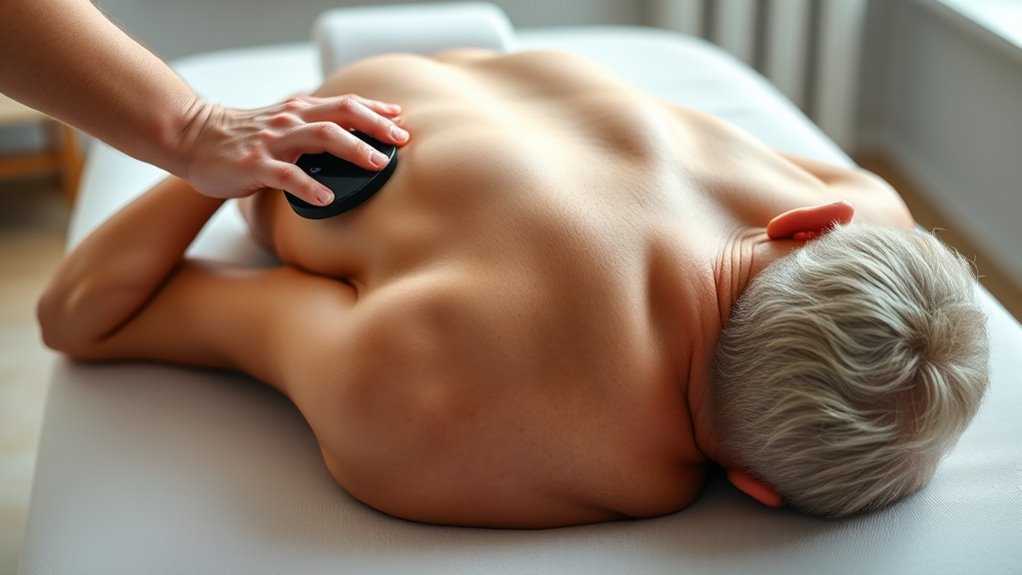
Percussive therapy employs rapid, targeted pulses to relax muscles and alleviate pain, making it a promising option for managing fibromyalgia symptoms. This technique uses vibration therapy to stimulate muscle tissue, encouraging blood flow and reducing muscle tension. The rhythmic pulses help break up knots and tightness, providing relief from soreness and discomfort. By stimulating muscle fibers, percussive therapy can enhance muscle flexibility and promote faster recovery. Its intended benefits include decreasing muscle stiffness, easing pain, and improving overall muscle function. You might experience a soothing, almost massage-like sensation that helps your muscles relax more deeply. Additionally, the use of percussive therapy can support muscle recovery and help in reducing fatigue associated with chronic conditions. This form of therapy is designed to target sore or tender areas, offering a non-invasive way to support your body’s healing process.
Scientific Evidence Supporting Percussive Therapy for Muscle Relief
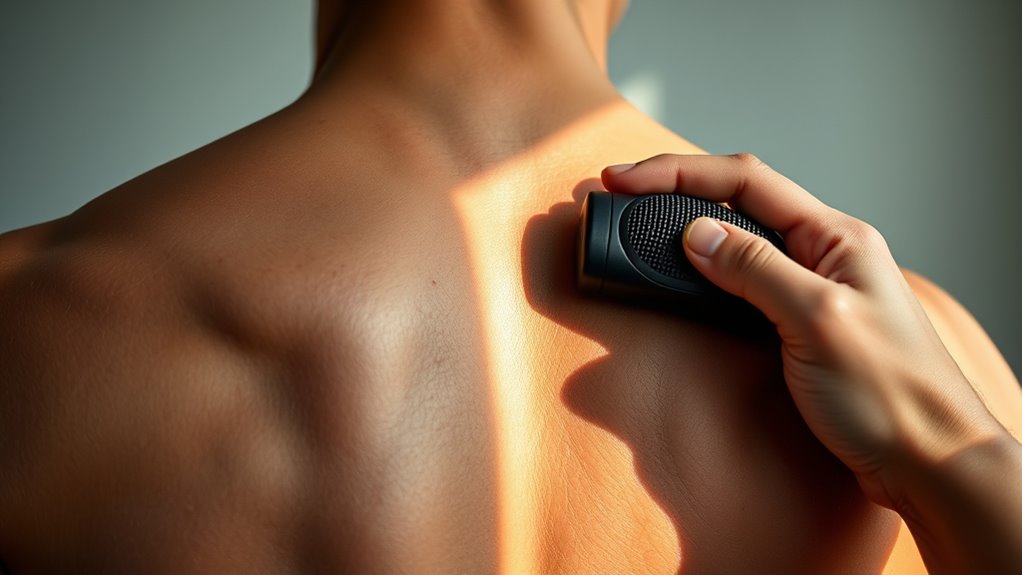
Scientific studies show that percussive therapy can effectively reduce muscle tension and improve blood flow. This increased circulation helps your muscles recover faster and feel less stiff. Additionally, research suggests it may decrease pain signals, providing relief for those with fibromyalgia. Building on its historical roots, there is growing evidence that such therapies can enhance overall well-being by promoting relaxation and reducing stress.
Reduced Muscle Tension
Research indicates that percussive therapy can effectively reduce muscle tension by promoting increased blood flow and breaking up muscle knots. When applied to tight areas, it targets trigger points that cause pain and stiffness. The rhythmic percussion helps loosen these knots, restoring flexibility and easing discomfort. Scientific studies show that this therapy decreases muscle tightness quickly, making it a valuable tool for those with fibromyalgia. By disrupting the cycle of persistent muscle contraction, percussive therapy allows muscles to relax more fully. This relief from tension not only reduces soreness but also prevents the formation of new trigger points. Additionally, incorporating mindfulness techniques can enhance the effectiveness of muscle relaxation practices. Overall, regular use helps maintain muscle elasticity and promotes a more relaxed, pain-free state, supporting your efforts to manage muscle-related symptoms effectively.
Enhanced Blood Flow
By increasing blood flow to muscles, percussive therapy accelerates the delivery of oxygen and nutrients essential for muscle repair and recovery. Improved blood circulation means your muscles get the fuel they need faster, promoting tissue oxygenation and faster healing. This boost in circulation can help reduce fatigue and restore strength, making everyday movements easier. Additionally, the use of AI-driven health monitoring tools can optimize therapy sessions based on your individual needs. Feel the difference as your muscles recover more quickly, helping you stay active and pain-free. Percussive therapy supports your body’s natural healing process, giving you renewed energy and resilience.
- Experience relief from persistent muscle tightness
- Feel energized with improved recovery
- Reduce soreness and stiffness faster
- Restore your body’s natural balance
- Reclaim your mobility and confidence
Decreased Pain Signals
Percussive therapy helps reduce pain signals sent from muscles to the brain, providing noticeable relief. It promotes muscle relaxation, which decreases tension that often amplifies pain perception. By stimulating deep tissues, percussive therapy enhances pain modulation, helping your nervous system better manage discomfort. This targeted treatment can interrupt the cycle of muscle tightness and pain, allowing your body to send fewer distress signals. As muscles relax, fewer pain signals reach your brain, making discomfort feel more manageable. Scientific evidence shows that percussive therapy effectively reduces muscle soreness and pain intensity, especially for those with fibromyalgia. Regular sessions help your body adapt by calming overactive pain pathways and improving overall muscle function, leading to sustained relief and a better quality of life. Additionally, research into neuroplasticity suggests that such therapies may promote long-term changes in pain processing pathways, further supporting their effectiveness.
Limitations and Risks of Using Percussive Devices With Fibromyalgia
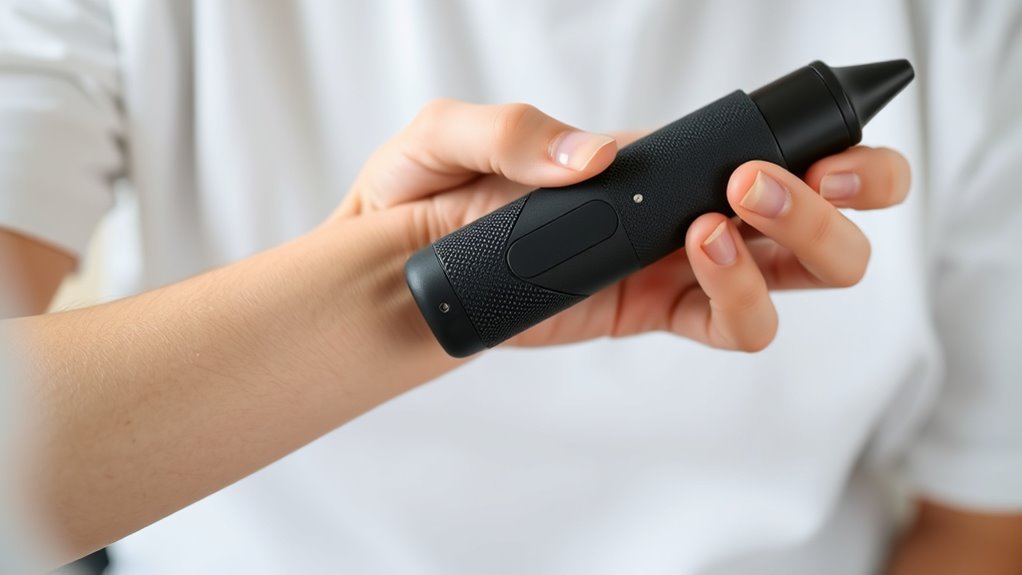
While percussive therapy offers potential relief for some fibromyalgia symptoms, it also comes with notable limitations and risks that you should be aware of. Using these devices may not be suitable for everyone, especially if you have sensitive areas or certain health conditions. You might experience increased pain, discomfort, or muscle soreness after use. Relying solely on percussive therapy could delay seeking effective alternative therapies or medical treatment. Additionally, it’s essential to contemplate medication interactions, as some drugs may heighten your sensitivity or adverse reactions. Be cautious if you have patches of inflammation, skin issues, or are pregnant. Ignoring these risks could worsen your condition or cause unforeseen health problems. Always consult your healthcare provider before integrating percussive devices into your fibromyalgia management plan. Understanding the community engagement around alternative treatments can also help you make informed decisions.
Personal Experiences and Anecdotal Reports From Patients

Many patients report varying levels of symptom relief with percussive therapy, but results differ from person to person. Some find significant pain reduction, while others notice little to no benefit. Hearing these personal stories can help you understand how this treatment might work for you. Incorporating evidence‑based practices may enhance the potential benefits and ensure safe application.
Symptom Relief Reports
Have patients with fibromyalgia noticed any relief after trying percussive therapy? Many share that it offers a glimmer of hope beyond traditional treatments. They report reduced muscle tension, decreased pain, and a sense of relaxation they hadn’t experienced with medication alone. Some find it complements alternative therapies, helping them feel more in control of their symptoms. Others mention that it minimizes medication interactions, allowing them to rely less on drugs. While responses vary, these personal stories highlight potential benefits and renewed optimism. If you’re seeking non-invasive options, these experiences suggest that percussive therapy might bring relief where other methods fall short. Additionally, understanding the performance and efficiency of therapeutic devices can help individuals choose safe and effective options.
Varied Treatment Responses
Patients’ experiences with percussive therapy vary widely, reflecting the complex nature of fibromyalgia. Some find relief, especially when combined with alternative therapies like gentle stretching or mindfulness, while others see little benefit. You might notice that your response depends on factors like the severity of symptoms or medication interactions. For some, percussive therapy offers temporary relief, but for others, it can exacerbate discomfort. It’s important to listen to your body and adjust accordingly. Keep in mind that individual responses are unpredictable, so what works for one person may not work for another. Consulting with your healthcare provider can help you determine whether percussive therapy fits into your overall treatment plan and how it interacts with your current medications. Additionally, understanding dog names can be helpful if you’re considering a therapy pet or simply want to explore naming options for a support animal.
Integrating Percussive Therapy Into a Comprehensive Pain Management Plan
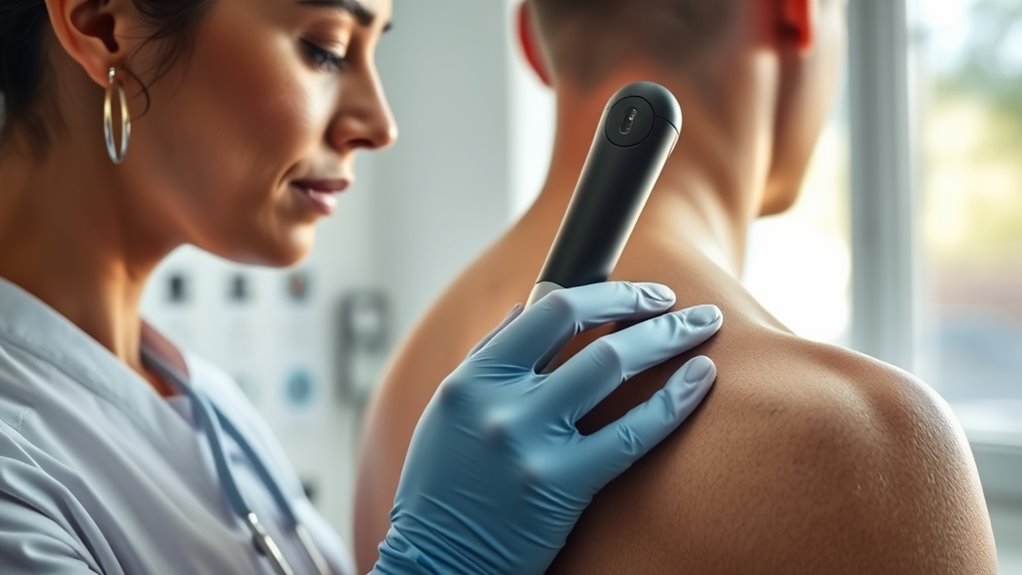
Integrating percussive therapy into a thorough pain management plan requires a strategic approach tailored to individual needs. It’s about combining effective tools like alternative therapies and lifestyle modifications to create a balanced routine. When you incorporate percussive therapy thoughtfully, you can experience relief while empowering yourself to take control of your condition. This integration might involve experimenting with timing, intensity, and complementary practices to find what works best for you. Keep in mind, your journey is unique, and progress may come gradually. Embrace the process with patience and optimism, knowing that combining therapies can enhance your overall well-being. Incorporating mindfulness techniques can also help manage stress and improve your response to pain. Mindfulness practices can foster a calmer mental state, supporting your healing process.
Consulting Healthcare Professionals Before Starting New Treatments
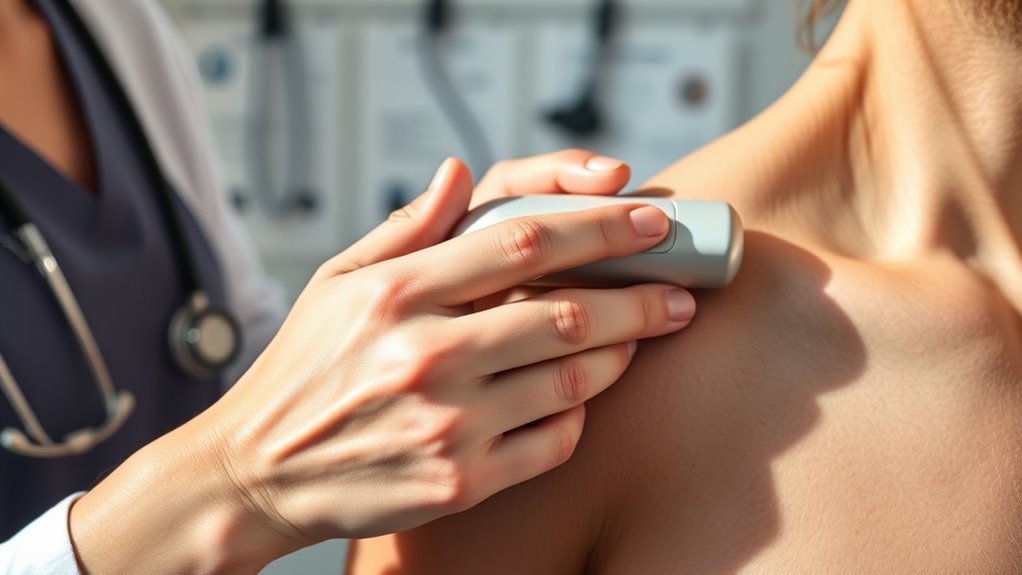
Before starting any new treatment, it’s essential to consult with healthcare professionals to guarantee safety and appropriateness for your specific condition. They can help evaluate whether options like alternative therapies or lifestyle modifications suit you. A professional’s guidance ensures you avoid potential risks and maximize benefits. When discussing treatments, consider this overview:
| Treatment Type | Benefits | Risks |
|---|---|---|
| Percussive Therapy | Reduces muscle tension | Possible soreness |
| Alternative Therapies | May improve well-being | Lack of scientific evidence |
| Lifestyle Modifications | Enhances daily functioning | Requires consistency |
| Medications | Pain relief | Side effects |
Always seek expert advice to tailor your approach and ensure safe, effective management of fibromyalgia. Understanding payment solutions can help you make more informed decisions about managing healthcare expenses.
Future Research and Developments in Fibromyalgia Treatment Options

Advances in fibromyalgia research are paving the way for more targeted and effective treatments. Future developments focus on understanding genetic factors that influence susceptibility, which could lead to personalized therapies. Researchers are also exploring how lifestyle modifications, like tailored exercise and stress management, can ease symptoms and improve quality of life. These innovations offer hope for those who’ve struggled with traditional options. You may soon have access to treatments that address your unique genetic makeup and lifestyle needs. The goal is to develop therapies that provide lasting relief and empower you to manage your condition confidently. As science progresses, the promise of more precise, holistic solutions becomes clearer, helping you regain control and live a fuller life. Emerging therapies are also being studied to enhance treatment effectiveness and patient outcomes.
Frequently Asked Questions
Can Percussive Therapy Cure Fibromyalgia Symptoms Permanently?
You might wonder if percussive therapy can permanently cure fibromyalgia symptoms. While some find relief through alternative therapies like percussive therapy, it doesn’t guarantee a permanent fix. Managing fibromyalgia often requires a combination of treatments, including mental health support and lifestyle changes. You should consult your healthcare provider to explore personalized ways to reduce symptoms, but don’t expect any quick, permanent cure from a single therapy.
How Often Should Fibromyalgia Patients Use Percussive Devices Safely?
Imagine gentle waves lapping at your skin—this is how percussive therapy should feel. For safe use, follow the frequency guidelines provided by your healthcare provider, typically limiting sessions to a few times a week. Always prioritize safety precautions, listening to your body, and avoiding overuse. Regular but moderate application helps manage symptoms without risking irritation or discomfort, ensuring you benefit without harm.
Are There Specific Types of Percussive Devices Best Suited for Fibromyalgia?
You should look for percussive devices designed to prioritize user comfort and device safety. Opt for lightweight, adjustable models with gentle percussion settings that suit sensitive fibromyalgia areas. Devices with multiple speed options allow you to customize the experience, guaranteeing comfort. Always follow manufacturer guidelines and consult your healthcare provider to ensure the device’s safety and effectiveness for your specific needs, reducing the risk of discomfort or injury.
Does Percussive Therapy Interact With Common Fibromyalgia Medications?
Think of percussive therapy as a gentle dance partner. You might wonder if it interacts with your fibromyalgia medications. Generally, these devices are safe when used properly, but medication interactions can vary. Always check with your healthcare provider to ensure device safety and avoid unexpected side effects. Being cautious helps you enjoy the benefits without turning the therapy into a misstep.
Can Children or Elderly With Fibromyalgia Benefit From Percussive Therapy?
You might wonder if children or elderly with fibromyalgia can benefit from percussive therapy. Child safety is a key concern, so it’s essential to consult healthcare providers before use. For the elderly, percussive therapy can offer benefits like pain relief and improved circulation, but they need tailored treatment. Always prioritize safety and professional guidance to guarantee this therapy is appropriate for their specific health needs.
Conclusion
While percussive therapy shows promise for muscle relief, it’s not a cure for fibromyalgia, which affects over 4 million adults in the U.S. alone. You should approach this treatment cautiously, consulting healthcare professionals to develop an extensive plan. Keep in mind that personal experiences vary, and ongoing research continues to explore safe, effective options. Staying informed and working closely with your doctor can help you find the best strategies to manage your symptoms effectively.



